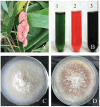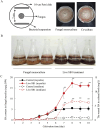Production of fungal hypocrellin photosensitizers: Exploiting bambusicolous fungi and elicitation strategies in mycelium cultures
- PMID: 40415904
- PMCID: PMC12096664
- DOI: 10.1080/21501203.2024.2430726
Production of fungal hypocrellin photosensitizers: Exploiting bambusicolous fungi and elicitation strategies in mycelium cultures
Abstract
Hypocrellins, a group of naturally occurring perylenequinone pigments produced by Shiraia bambusicola, are notable for their potential use in photodynamic therapy (PDT) for treating cancers and viruses. Traditionally, hypocrellins have been extracted from the fruiting bodies of S. bambusicola, a parasitic fungus on bamboo. However, the yield from wild Shiraia fruiting bodies is often insufficient, prompting a shift towards seeking other fungi with higher yields of hypocrellins as alternative sources. This review comprehensively examines the current research on the isolation, identification, and bioactivity of fungal perylenequinones from Shiraia isolates from ascostromata or fruiting bodies, Shiraia-like endophytes, and other endophytes from bamboos. Additionally, the review discusses the culture methods and conditions for solid-state and submerged fermentation of hypocrellin-producing fungi, including medium components, culture conditions, and optimisation of fermentation factors, as mycelium cultures have emerged as a promising alternative for the production of hypocrellins. Furthermore, novel elicitation strategies are presented to address the bottleneck of lower production of hypocrellins in mycelium cultures, focusing on the preparation, characterisation, and application of biotic and abiotic elicitors. This review aims to facilitate further exploration and utilisation of fungal resources and elicitation strategies for enhanced production of hypocrellins in mycelium cultures.
Keywords: Shiraia; elicitation; endophytes; hypocrellins; mycelium culture.
© 2024 The Author(s). Published by Informa UK Limited, trading as Taylor & Francis Group.
Conflict of interest statement
No potential conflict of interest was reported by the author(s).
Figures










Similar articles
-
Effects of branched-chain amino acids on Shiraia perylenequinone production in mycelium cultures.Microb Cell Fact. 2023 Mar 24;22(1):57. doi: 10.1186/s12934-023-02066-6. Microb Cell Fact. 2023. PMID: 36964527 Free PMC article.
-
Contrasting regulation of live Bacillus cereus No.1 and its volatiles on Shiraia perylenequinone production.Microb Cell Fact. 2022 Aug 23;21(1):172. doi: 10.1186/s12934-022-01897-z. Microb Cell Fact. 2022. PMID: 35999640 Free PMC article.
-
Inducing perylenequinone production from a bambusicolous fungus Shiraia sp. S9 through co-culture with a fruiting body-associated bacterium Pseudomonas fulva SB1.Microb Cell Fact. 2019 Jul 5;18(1):121. doi: 10.1186/s12934-019-1170-5. Microb Cell Fact. 2019. PMID: 31277643 Free PMC article.
-
Biotechnological production and potential applications of hypocrellins.Appl Microbiol Biotechnol. 2023 Nov;107(21):6421-6438. doi: 10.1007/s00253-023-12727-6. Epub 2023 Sep 11. Appl Microbiol Biotechnol. 2023. PMID: 37695342 Review.
-
Hypocrellins and their use in photosensitization.Photochem Photobiol. 1990 Sep;52(3):609-16. doi: 10.1111/j.1751-1097.1990.tb01807.x. Photochem Photobiol. 1990. PMID: 2284353 Review.
References
-
- Alferova VA, Mikhnovets IE, Chistov AA, Korshun VA, Tyurin AP, Ustinov AV.. 2022. Medicinal chemistry of tick-borne encephalitis. In: Chapter 3, Perylene as a controversial antiviral scaffold. Amsterdam: Elsevier; p. 93–156. doi: 10.1016/bs.armc.2022.08.001. - DOI
-
- Amano N. 1980. Studies on the Japanese Loculoascomycetes: II. Taxonomic position of the genus Shiraia. Bull Natl Sci Mus Ser B (Bot). 6:55–61.
-
- Amano N. 1983. On the type specimen of Shiraia bambusicola. Trans Mycol Soc Jpn. 24(1):35–38.
Publication types
LinkOut - more resources
Full Text Sources
